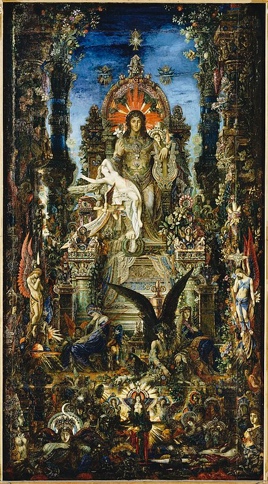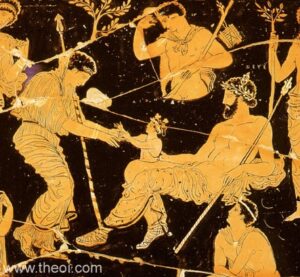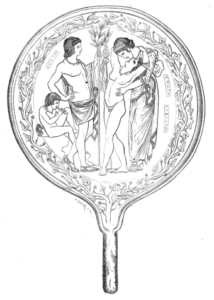
Many things have been done in the name of love, both negative and positive, as this feeling encompasses a range of emotions and mental states. This love can often lead to unexpected developments and to the punishment of either one or both parties involved. This is the case of Semele, whose curiosity as to who her lover was, led to her destruction as she did not take into consideration the unexpected presence of Hera and the punishment that followed her actions.
Jupiter (Zeus) and Semele (1894-95) Gustave Moreau
Semele, which means ‘mother of the earth’, was a Princess of Thebes (Greek: Θήβα), a city in Boeotia, Central Greece and one of the oldest continuously inhabited cities in the world. In Greek mythology, she was the youngest daughter of King Cadmus, the founder of Thebes. His wife was the immortal goddess Harmonia (Greek: Αρμονία – ‘harmony’, ‘agreement’). Her counterpart was Eris, the goddess of strife and discord. Semele was the mother of Dionysus by Zeus(Greek: Διόνυσος), God of the grape-harvest, wine making, fertility, festivity, religious ecstasy, and the theatre.
Zeus, king of the twelve Olympian gods, was flying over one of his temples in the guise of an eagle as Semele, who was priestess at the temple, was cleansing herself in the river Asopus after having sacrificed a bull in his honour. He fell in love with her and began to visit her secretly.
Hera, Zeus’ wife, was queen of the Olympian gods as well as goddess of marriage, women and family, and the protector of women during childbirth. However, if anyone offended her, and especially when having to deal with Zeus’ numerous love affairs and illegitimate offspring, she became very jealous and vengeful in her dealings with them.
When Hera found out about the relationship between Zeus and Semele, she took on the form of an old woman. She befriended Semele, who soon confided in her that her lover was Zeus. Hera planted seeds of doubt in Semele’s mind by pretending that this could not be true. To find out the truth, Semele asked Zeus to reveal himself so that she could see him in all his glory. Although he had promised on the river Styx, the boundary between Earth and the Underworld, that he would tell her whatever she wanted, Zeus begged her not to persist as he knew the outcome of his disclosure. Semele persisted and so Zeus was forced by his oath to comply. Zeus tried to show her the smallest of his bolts and thunderstorm clouds to protect her from harm. However, mortals cannot look upon the gods without being incinerated. Within seconds, she perished, consumed by the flames.

Zeus was able to rescue the fetal Dionysus and sewed him into his thigh. Thus, the descriptive term Eiraphiotes or insewn as mentioned in the Homeric hymns that refer to the individual gods. A few months later, Dionysus was born. He is therefore also referred to as twice born.
Apulian red-figure volute crater C4th BC. National Archaeological Museum of Taranto showing the infant Dionysus and Zeus.
 When he grew up, he was aided by the shepherd Prosymnus, who lived by the bottomless Alcyonian Lake near the prehistoric site of Lerna, to enter the Underworld and rescue his mother. She became a goddess on Mount Olympus taking the name Thyone. She presided over the frenzy, which seized the female devotees of Dionysus during the orgies that were regularly organised.
When he grew up, he was aided by the shepherd Prosymnus, who lived by the bottomless Alcyonian Lake near the prehistoric site of Lerna, to enter the Underworld and rescue his mother. She became a goddess on Mount Olympus taking the name Thyone. She presided over the frenzy, which seized the female devotees of Dionysus during the orgies that were regularly organised.
Semele embracing her son Dionysus with Apollo looking on and a satyr playing an aulos. Drawing from an Etruscan mirror.
Aeschylus, often referred to as the father of tragedy, wrote the play Semele. However, it has been lost except for a few lines and a papyrus fragment from Oxyrhynchus, an ancient city to the west of the river Nile, in Egypt.